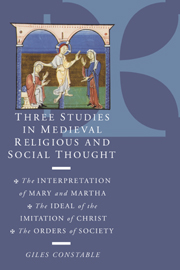 Three Studies in Medieval Religious and Social Thought
Three Studies in Medieval Religious and Social Thought Book contents
- Frontmatter
- Contents
- List of illustrations
- Preface
- List of abbreviations
- I THE INTERPRETATION OF MARY AND MARTHA
- II THE IDEAL OF THE IMITATION OF CHRIST
- The imitation of the divinity of Christ
- The imitation of the humanity of Christ
- The imitation of the body of Christ
- The late Middle Ages
- III THE ORDERS OF SOCIETY
- Bibliography of secondary works
- Index of manuscripts
- Biblical index
- General index
The imitation of the divinity of Christ
Published online by Cambridge University Press: 08 December 2009
- Frontmatter
- Contents
- List of illustrations
- Preface
- List of abbreviations
- I THE INTERPRETATION OF MARY AND MARTHA
- II THE IDEAL OF THE IMITATION OF CHRIST
- The imitation of the divinity of Christ
- The imitation of the humanity of Christ
- The imitation of the body of Christ
- The late Middle Ages
- III THE ORDERS OF SOCIETY
- Bibliography of secondary works
- Index of manuscripts
- Biblical index
- General index
Summary
the concept of imitation or mimesis, in its religious sense, is found in several texts in the New Testament broadly grouped around the theme of following God and Christ. The meanings of the terms varied, as did the contexts in which they were used, and scholars have long debated over the exact meaning of ‘to follow’ and ‘to imitate’ in the Bible. For medieval Latin Christianity the most important texts were the seven times Paul used the term imitator, four in reference to himself and, through himself, to God and Christ, and one each in reference to God, the faithful, and the churches of God. Imitator is usually translated ‘follower’ in English versions of the Bible, as in ‘Be ye followers of me’ (1 Corinthians 4.16 and 11.1 and Philippians 3.17) and ‘become followers of us and the Lord’ (1 Thessalonians 1.6). This tends to equate the concepts of imitating and following, and to associate the imitation of Christ with the precepts to ‘Take up His cross and follow me’, ‘Take up My yoke upon you and learn of Me’, and walk ‘even as He walked’, and Peter's statement that Christ left ‘an example that you should follow His steps’. This view was supported by Augustine's question in On holy virginity: ‘For what is to follow except to imitate (Quid est enim sequi nisi imitari)?’
- Type
- Chapter
- Information
- Three Studies in Medieval Religious and Social ThoughtThe Interpretation of Mary and Martha, the Ideal of the Imitation of Christ, the Orders of Society, pp. 145 - 168Publisher: Cambridge University PressPrint publication year: 1995
- 3
- Cited by


